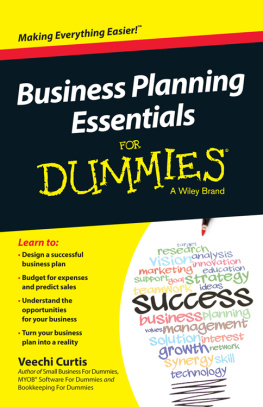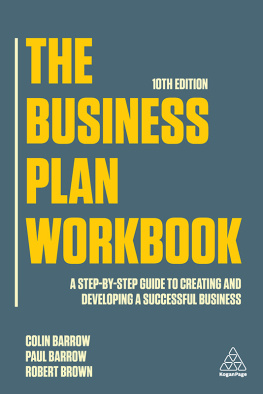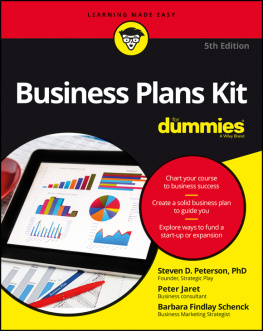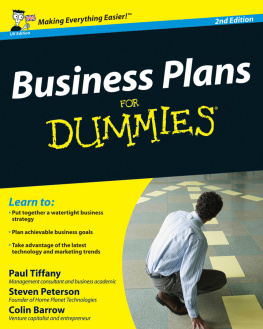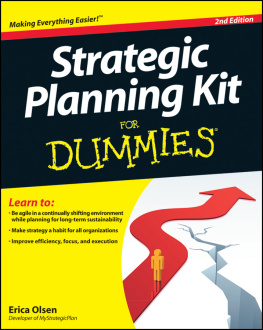How to Write a Business Plan
Fourth Edition
How to Write a Business Plan
Fourth Edition
Edwin T. Crego, Jr.
The TQS Group, Inc.
Peter D. Schiffrin
The TQS Group, Inc.
James C. Kauss
McGladrey & Pullen

1986, 1990, 1995 American Management Association. Also 1982 Education for Management, Inc. All rights reserved. This material may not be reproduced, stored in a retrieval system, or transmitted in whole or in part, in any form or by any means, electronic, mechanical photocopying, recording, or otherwise, without the prior written permission of the publisher.
Printed in the United States of America
Contents
About This Course
As one course among many offered in the American Management Associations curriculum, How to Write a Business Plan, Fourth Edition, has been designed specifically for the practicing manager and the future manager. It provides private, self-paced, individualized study; learning and self-evaluation through in-text exercises; and communication between the student and AMAs Educational Services instructors through assignments and a final examination based on the case study as pioneered by Harvard University. Paralleling a business school course of study, AMAs curriculum provides practical information to working professionals who, on their own time and at their own pace, want to continue their education.
This course was prepared by senior staff of The TQS Group, Inc., and McGladrey & Pullen. The TQS Group is a consulting and training firm that specializes in customer-centered quality improvement and organizational reengineering. McGladrey & Pullen is a national accounting and consulting firm.
Edwin T. Crego, Jr., is the Managing Director of The TQS Groups Chicago office. Mr. Crego is a nationally recognized expert in the planning field. He specializes in customer research, strategy development, and organizational change management. Mr. Crego has more than 20 years experience as a consultant. He was formerly Director of Laventhol & Horwaths Organizational Consulting Division and President of CONSULT, Ltd. He received his MA and BA degrees from the University of Illinois.
Peter D. Schiffrin is the Managing Director of The TQS Groups Philadelphia office. He is an authority in the planning field and is a frequent speaker on strategy, quality, and management issues. Mr. Schiffrin has an MBA from the Wharton School of Business and is a member of the Institute of Management Consultants and the Planning Forum.
James C. Kauss is a management consultant for McGladrey & Pullen, a national accounting and consulting firm that services the middle market. Mr. Kauss helps clients improve their management techniques and raise employee performance levels through improved human resources systems. He typically focuses on teaching strategic planning and executive incentive programs and provides management consulting services.
The publisher wishes to thank the following people for their help in reviewing the manuscript of this course: John Beveridge, CISA, CFE, Ipswich, Massachusetts; Jack Dolmat-Connell, President, Human Resources & Management Consultants, Princeton, Massachusetts; and James M. Lynch, Benchmark Consulting Group, Boston, Massachusetts.
How to Take This Course
This course consists of text material for you to read and four types of learning activities (the review questions, the first examination, the practice case, and the examination case or, in some cases, a multiple-choice final examination) for you to complete. Credit will be given only upon successful completion of the examination case or, if applicable, the final examination.
.
The various activities are designed to reinforce the concepts brought out in the text portion of the course and to enable you to evaluate your progress. The examination case will be evaluated and graded by an AMA staff instructor so that certain concepts you may otherwise have overlooked or misunderstood in your own study will be brought to your attention and clarified.
We recommend that you work at this course in a systematic way. Only by reading the text and working through the review questions at a regular and steady pace will you get the most out of this course and retain what you have learned
The Text
The most important component of this course is, obviously, the text, for it is here that the concepts and methods are first presented. Reading each chapter twice will increase the likelihood of your understanding the text fully.
In your first reading, concentrate on getting an overview of the chapters contents. Read the learning objectives at the beginning of the chapter first. They will act as guidelines to the major topics of the chapter and enumerate the skills you should master as you study the text. As you read the chapter, pay attention to the headings and subheadings. Find the general theme of each section and see how that theme relates to others. Dont let yourself get bogged down with details during the first reading; simply concentrate on remembering and understanding the major themes.
In your second reading, look for the details that underlie the themes. Read the entire chapter carefully and methodically, underlining key points, working out the details of the examples, and making marginal notations as you go.
The Review Questions
After reading a chapter and before going on to the next, work through the review questions. Answering the questions and comparing your own answers to those given will assist you in grasping the major ideas of that chapter. If you perform these self-check exercises conscientiously, you will develop a framework in which to place material presented in later chapters. This building of a mental model will help clarify the reading and, most important, will help you to apply what you have learned to your particular work situation.
The First Examination
The first examination is made up of a series of straightforward questions on what you have studied in both the text and the review questions. Answer the questions using the enclosed scannable answer form and mail the form in one of the return envelopes to:
American Management Association
Educational Services
P.O. Box 133
Florida, NY 10921
The first examination will be graded and returned to you promptly so you may restudy areas in the course with which you had trouble.
The Practice Case
The practice case presents the activities of a fictitious organization. Questions are raised that prompt you to apply the concepts you have just learned in the body of the text. The practice case, as its name implies, prepares you for the written analysis required of you in the final portion of the course, the examination case. There is no one correct answer to the practice case; it is intended to show you the thinking process involved in completing the examination case. However, there is a suggested solution to the practice case; you can compare your solution to the suggested solution.
The Examination Case
The examination case presents details of a specific company with a problem or problems for you to solve. Because solutions to even the smallest problems in a real-life situation often have important ramifications, think through your analysis thoroughly before you compose your answers to the questions.
Next page

